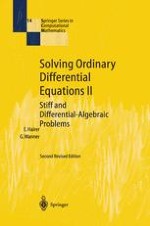"Whatever regrets may be, we have done our best." (Sir Ernest Shack 0 leton, turning back on 9 January 1909 at 88 23' South.) Brahms struggled for 20 years to write his first symphony. Compared to this, the 10 years we have been working on these two volumes may even appear short. This second volume treats stiff differential equations and differential algebraic equations. It contains three chapters: Chapter IV on one-step (Runge-Kutta) meth ods for stiff problems, Chapter V on multistep methods for stiff problems, and Chapter VI on singular perturbation and differential-algebraic equations. Each chapter is divided into sections. Usually the first sections of a chapter are of an introductory nature, explain numerical phenomena and exhibit numerical results. Investigations of a more theoretical nature are presented in the later sections of each chapter. As in Volume I, the formulas, theorems, tables and figures are numbered con secutively in each section and indicate, in addition, the section number. In cross references to other chapters the (latin) chapter number is put first. References to the bibliography are again by "author" plus "year" in parentheses. The bibliography again contains only those papers which are discussed in the text and is in no way meant to be complete.
